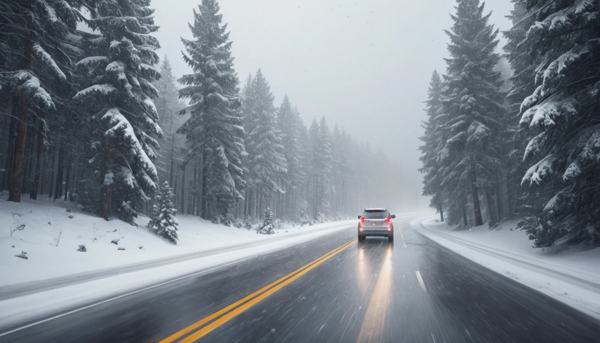Winter driving safety tips video shows you smart ways to drive safely in snow, ice, and storms. Master winter roads with confidence.
Winter Driving Safety Tips Video – Your Cold-Weather Survival Guide ❄️🚗
Ever wondered why some drivers seem okay in snow and ice?
Winter driving is about being ready, aware, and knowing what to do.
If you’re looking for winter driving safety tips video, you want to drive safely. In this guide, I’ll share everything you need to know. You’ll feel confident driving, even when it’s snowy.
Why Winter Driving Is Different 🌨️
Driving in winter is a new challenge. The roads change, you see less, and your car acts differently. Ice makes it hard to stop, snow hides dangers, and cold affects your tires and battery.
When you watch a winter driving safety tips video, notice how pros prevent problems. Think ahead, not just react.
Essential Gear Before You Hit the Road 🎒
Before winter starts, make sure your car has these:
- Snow brush and ice scraper – clear your view before moving.
- Jumper cables – cold kills batteries fast.
- Blankets and gloves – for warmth if stranded.
- Small shovel – dig out if stuck.
- Road salt or kitty litter – traction booster.
Pro Tip: Keep your gear in an easy-to-reach tote in your trunk, not buried under groceries.
Checking Your Vehicle Before Every Trip 🔍
A quick check before driving can save your life:
- Tire tread depth – aim for at least 4/32″ in winter.
- Tire pressure – cold air drops PSI fast.
- Lights – snow can block headlights.
- Windshield washer fluid – choose freeze-resistant.
- Brakes – any noise means get them checked.
| Pre-Drive Winter Safety Checklist | Why It Matters |
|---|---|
| Tire tread & pressure | Better traction on slippery roads |
| Headlights & taillights | Improves visibility in storms |
| Wiper blades & fluid | Keeps windshield clear |
| Battery health | Prevents no-start situations |
| Emergency kit | Keeps you safe if stranded |
Slow Down – Always 🐢
Speed limits are for good weather, not icy roads. Going 5–10 mph slower can help.
Why? Ice makes stopping harder. If it takes 4 seconds to stop normally, it might take 12+ on ice.
Increase Following Distance 📏
In summer, follow 3 seconds behind. In winter, double or triple that.
Here’s how: Pick a roadside object. When the car ahead passes it, count seconds until you pass it.
Master the Art of Gentle Steering 🛞
Sudden steering moves can lead to loss of control. In slippery conditions:
- Ease into turns – no jerky movements.
- Avoid overcorrection – it makes spins worse.
- Look where you want to go – not where you’re sliding.
The Right Way to Brake on Ice 🛑❄️
If your vehicle has ABS: Press and hold the brake firmly, and let the system pulse.
Without ABS: Pump brakes gently to avoid locking wheels.
Remember: No brake system can defy physics—slow down early.
| Braking Method | With ABS | Without ABS |
|---|---|---|
| On Ice | Firm, steady pressure | Gentle pumping |
| On Snow | Steady pressure | Slow pumping |
| On Slush | Controlled pressure | Controlled pumping |
Avoid Cruise Control in Snow & Ice 🚫
Cruise control can make your car accelerate on slippery spots without you noticing, causing skids. Keep control with your foot on the pedal.
Handling a Skid 🔄
If your back wheels slide:
- Take your foot off the gas.
- Steer gently in the direction you want to go.
If your front wheels slide:
- Ease off the gas and let the wheels regain grip.
Stay Visible in Storms 🌫️
- Turn on headlights in snow or rain (day or night).
- Clear taillights regularly—snow builds fast.
- Use hazard lights if moving slowly.
Know When to Stay Home 🏠
No video tip beats the safest advice: if conditions are dangerous, don’t drive. Even experienced winter drivers avoid blizzards when possible.
| Condition | Risk Level | Best Action |
|---|---|---|
| Light Snow | Low | Drive with caution |
| Heavy Snow | High | Delay travel if possible |
| Ice/Freezing Rain | Extreme | Avoid driving |
| Blizzard | Severe | Stay home |
What to Look For in a Winter Driving Safety Tips Video 🎥
When searching online:
- Real demonstrations in snow and ice
- Slow-motion replays of braking/steering
- Professional driver commentary
- Checklists you can screenshot
Key Takeaways 📌
- Slow down and keep a bigger gap.
- Prepare your car before winter.
- Brake gently and steer smoothly.
- Avoid cruise control in icy conditions.
- Stay home in extreme weather.
Quick Answers ⚡
- Winter driving needs slower speeds and more space.
- Prep your car with winter gear and inspections.
- Skid recovery is about gentle steering, not panic.
Deep Comparisons – Snow vs. Ice Driving 🥶
Driving on snow: You have some traction; tires can grip packed snow better than ice.
Driving on ice: Traction is near zero; stopping distance triples, and steering is minimal.
Snow often gives warning signs (slushy feel), but ice—black ice—can be invisible.
Conclusion 🏁
Winter driving is all about anticipation, patience, and preparation. The best winter driving safety tips videos give you visual, step-by-step examples. But the real safety comes from practicing these skills before you need them.
Stay ready, stay calm, and remember—getting there safely is always more important than getting there fast.
FAQs ❓
1. How do I drive safely in heavy snow?
Slow down, keep extra distance, and use gentle braking. Turn on headlights for visibility. Avoid sudden moves that cause skids.
2. What should I do if my car skids on ice?
Ease off the gas and steer gently where you want to go. Avoid slamming the brakes. Regain traction before accelerating.
3. Should I warm up my car before driving in winter?
Yes, but only for 1–2 minutes. Longer idling wastes fuel and isn’t needed for modern engines.
4. How can I stop faster on snowy roads?
Brake gently and early. Use ABS correctly if equipped. Keep tires in top condition.
5. What’s the safest speed for icy roads?
There’s no fixed number. Drive slow enough to maintain control—often much lower than posted limits.
References:
https://www.nhtsa.gov/winter-driving-tips
https://www.weather.gov/safety/winter-driving
https://exchange.aaa.com/safety/driving-advice/winter-driving-tips




